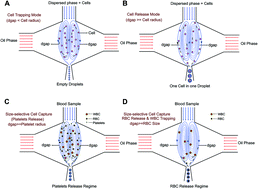Our official English website, www.x-mol.net, welcomes your feedback! (Note: you will need to create a separate account there.)
High-efficiency single cell encapsulation and size selective capture of cells in picoliter droplets based on hydrodynamic micro-vortices
Lab on a Chip ( IF 6.1 ) Pub Date : 2017-10-23 00:00:00 , DOI: 10.1039/c7lc00972k Gopakumar Kamalakshakurup 1, 2, 3, 4, 5 , Abraham P. Lee 1, 2, 3, 4, 6
Lab on a Chip ( IF 6.1 ) Pub Date : 2017-10-23 00:00:00 , DOI: 10.1039/c7lc00972k Gopakumar Kamalakshakurup 1, 2, 3, 4, 5 , Abraham P. Lee 1, 2, 3, 4, 6
Affiliation

|
Single cell analysis has emerged as a paradigm shift in cell biology to understand the heterogeneity of individual cells in a clone for pathological interrogation. Microfluidic droplet technology is a compelling platform to perform single cell analysis by encapsulating single cells inside picoliter–nanoliter (pL–nL) volume droplets. However, one of the primary challenges for droplet based single cell assays is single cell encapsulation in droplets, currently achieved either randomly, dictated by Poisson statistics, or by hydrodynamic techniques. In this paper, we present an interfacial hydrodynamic technique which initially traps the cells in micro-vortices, and later releases them one-to-one into the droplets, controlled by the width of the outer streamline that separates the vortex from the flow through the streaming passage adjacent to the aqueous–oil interface (dgap). One-to-one encapsulation is achieved at a dgap equal to the radius of the cell, whereas complete trapping of the cells is realized at a dgap smaller than the radius of the cell. The unique feature of this technique is that it can perform 1. high efficiency single cell encapsulations and 2. size-selective capturing of cells, at low cell loading densities. Here we demonstrate these two capabilities with a 50% single cell encapsulation efficiency and size selective separation of platelets, RBCs and WBCs from a 10× diluted blood sample (WBC capture efficiency at 70%). The results suggest a passive, hydrodynamic micro-vortex based technique capable of performing high-efficiency single cell encapsulation for cell based assays.
中文翻译:

基于流体动力学微涡旋的高效单细胞包囊和皮升液滴中细胞的大小选择性捕获
单细胞分析已成为细胞生物学的范式转变,以了解克隆中单个细胞的异质性以进行病理学询问。微流体液滴技术是通过将单个细胞封装在皮升至纳升(pL–nL)体积液滴内来执行单细胞分析的引人注目的平台。然而,基于液滴的单细胞测定的主要挑战之一是液滴中的单细胞封装,目前是由泊松统计或流体力学技术随机决定的。在本文中,我们提出了一种界面流体动力学技术,该技术首先将细胞捕获在微涡流中,然后将它们一对一释放到液滴中,d间隙)。在等于单元半径的d间隙处实现一对一封装,而在小于单元半径的d间隙处实现单元的完全俘获。该技术的独特之处在于,它可以在低的细胞负载密度下执行1.高效的单细胞封装和2.大小选择性的细胞捕获。在这里,我们展示了这两种功能,具有50%的单细胞包封效率和从10倍稀释的血液样本中选择性分离血小板,RBC和WBC的大小(WBC捕获效率为70%)。结果表明,一种被动的,基于流体动力微涡旋的技术能够对基于细胞的测定法进行高效的单细胞包封。
更新日期:2017-11-15
中文翻译:

基于流体动力学微涡旋的高效单细胞包囊和皮升液滴中细胞的大小选择性捕获
单细胞分析已成为细胞生物学的范式转变,以了解克隆中单个细胞的异质性以进行病理学询问。微流体液滴技术是通过将单个细胞封装在皮升至纳升(pL–nL)体积液滴内来执行单细胞分析的引人注目的平台。然而,基于液滴的单细胞测定的主要挑战之一是液滴中的单细胞封装,目前是由泊松统计或流体力学技术随机决定的。在本文中,我们提出了一种界面流体动力学技术,该技术首先将细胞捕获在微涡流中,然后将它们一对一释放到液滴中,d间隙)。在等于单元半径的d间隙处实现一对一封装,而在小于单元半径的d间隙处实现单元的完全俘获。该技术的独特之处在于,它可以在低的细胞负载密度下执行1.高效的单细胞封装和2.大小选择性的细胞捕获。在这里,我们展示了这两种功能,具有50%的单细胞包封效率和从10倍稀释的血液样本中选择性分离血小板,RBC和WBC的大小(WBC捕获效率为70%)。结果表明,一种被动的,基于流体动力微涡旋的技术能够对基于细胞的测定法进行高效的单细胞包封。


























 京公网安备 11010802027423号
京公网安备 11010802027423号